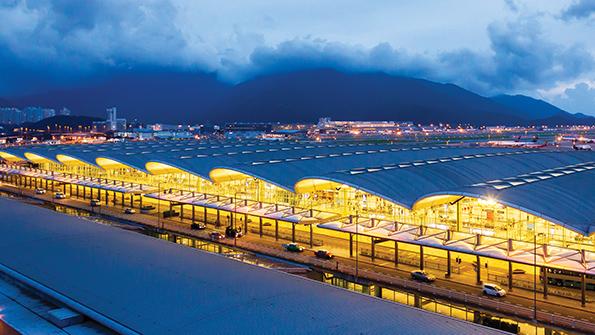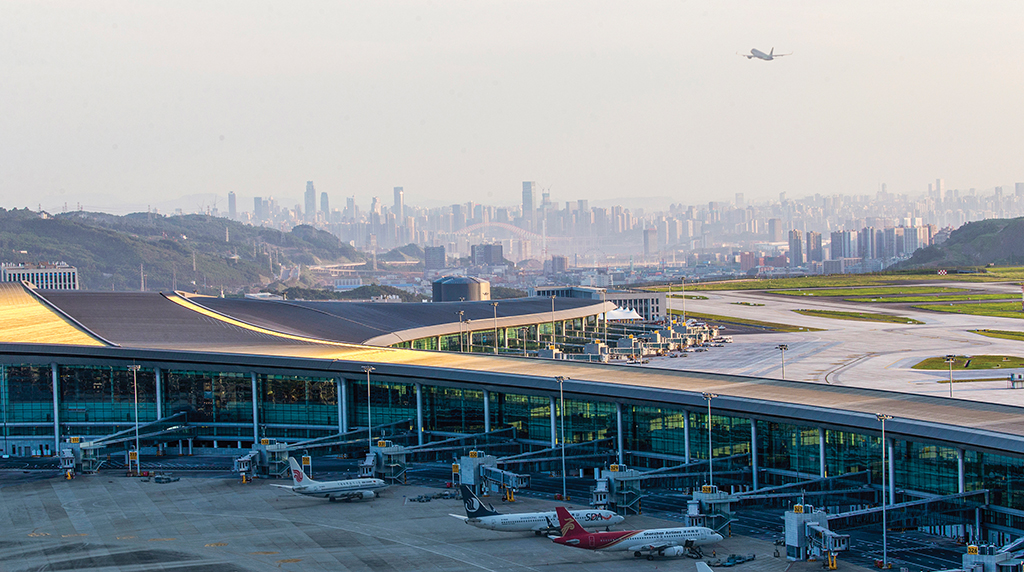
Hong Kong International Airport is expanding its connectivity with airports throughout the Greater Bay Area.
Hong Kong International Airport (HKIA) is celebrating a quarter century on Lantau Island and the Airport Authority of Hong Kong (AAHK) is transitioning it from a “city airport” to an “airport city,” promoting it as a hub for the Greater Bay Area (GBA).
The GBA is a huge catchment area consisting of cities around the Guangdong province, including Guangzhou, Shenzhen, Zhuhai, Macau and Hong Kong, with a population of 86 million that contributes 10% of the entire Chinese GDP.
Since the handover of Hong Kong from the UK to China in 1997, efforts to link the GBA with Hong Kong are making HKIA an intermodal air transport hub for the region. The massive 55 km (34.2 mi.) Hong Kong-Zhuhai-Macau Bridge links the three cities by road and creates what AAHK describes as a “bridgehead economy,” where passengers and cargo trucks will drive and park at a dedicated island at the bridgehead before being transported to the airport terminal.
The AAHK is also looking to increase its upstream check-in counters to 30 across the GBA cities, enabling passengers to check in for their flights out of HKIA from the mainland. Flagship airline Cathay Pacific will also open its first airline lounge at Shenzhen’s Shekou ferry terminal to cater to sail-fly customers.
During the COVID-19 pandemic, Cathay Cargo and AAHK tested the sea-air intermodal cargo system in which cargo is preprocessed and cleared in Dongguan, China, before being shipped on barges to a dedicated pier on HKIA’s airside, where it is loaded onto the aircraft.

AAHK is working on construction of a Dongguan-HKIA Logistics Park, which will be completed in 2025. This will increase HKIA air cargo competitiveness by reducing cargo processing costs by 50%.
AAHK understands the relevance of air cargo to the success of HKIA. Air cargo accounted for just 2% of Hong Kong total freight volume in 2022 but contributed 48% of its external trade value of $585 billion.
During the pandemic, HKIA retained the top spot as the world’s busiest cargo airport and it expects volumes to increase with the commissioning of a three-runway system. Along with new and expanded cargo handling facilities from DHL and Alibaba’s Cainiao, AAHK estimates that Hong Kong’s cargo capacity will increase from 7.5 million metric tons in 2019 to 10 million metric tons by 2035.
AAHK also used the downtime during COVID-19 and invested HK$9 billion ($1.15 billion) to spruce up the airport with new boarding gates, facial recognition token technologies, restrooms and the testing of autonomous airside vehicles.
AAHK Chief Operating Officer Vivian Leung said the airport wants to increase its revenue generation stream without adding cost to airlines. With the aim of making HKIA a lifestyle destination, construction has begun on Skycity, an area that includes hotels, offices, exhibition areas and an 800-unit shopping mall. The aim is to enable HKIA to generate retail revenue from both visitors and locals, similar to what Singapore Changi Airport has done with its Jewel complex.
Decimated by the pandemic, AAHK recognized that it needed to look beyond Hong Kong to survive and grow while collaborating with neighboring GBA airports to enhance connectivity.
“The idea is not for Hong Kong to return to pre-pandemic, but rather to become the hub of the entire GBA,” IATA director general Willie Walsh said at an Aviation Day event in Hong Kong.
CHONGQING
Meanwhile, the city of Chongqing holds a special place in China. It is one of the four municipalities under the direct administration of the central government, along with Beijing, Shanghai and Tianjin. It is also the only one of those municipalities located deep within China.
In the first half of this year, Chongqing Jiangbei International Airport (CKG) completed a passenger throughput of 21.8 million, returning to 96.4% of traffic versus the same period in 2019 and ranking it as China’s fifth-busiest airport. Like the rest of China, domestic traffic exceeded pre-pandemic levels by 2.6%, although international is slowly returning and stood at 38% of 2019 levels.
Chongqing Airport Group CEO Huang Wei said that, in accordance with the five-year international route development plan formulated by the Chongqing Municipal Government, the airport will first focus on strategic intercontinental routes and to Asia/Australia Regional Comprehensive Economic Partnership (RCEP) countries, as well as promote the opening of routes to major gateways such as New York, Paris, Tokyo, Manila in the Philippines and Jakarta, Indonesia.
He also said the airport will continue to serve its role as a transit channel connecting the eastern region with Xinjiang, Tibet and Yunnan in the west.
“The second focus is to introduce measures such as marketing promotion fee incentives and airport charge discounts to reduce the pressure on airlines and support airlines in stabilization of routes. Finally, the third plan is to strengthen the promotion of international routes in domestic and foreign markets, focusing on increasing the volume of inbound and transit customers.” Huang said.
In 2021, provincial capital Chengdu opened its second airport, Tianfu International Airport (TFU), just 280 km from CKG, becoming the third city in China to operate a dual airport concept. Huang said the opening has not affected CKG’s operating numbers, which continue to lead those of other western China airports. CKG has the advantage of being closer to the city center, while TFU—a major base for Air China—has large spaces for expansion.
Chongqing Airport Group’s objective is to establish a collaboration with the Sichuan Airport Group, capitalizing on their respective strengths. They intend to proactively explore and engage in diverse cross-disciplinary partnerships, with the shared goal of establishing a globally renowned airport cluster in the regions of Chengdu and Chongqing.
Airlines based at each will also promote the development of the core hub airports in Chengdu and Chongqing as an overall international route network. Both airports will promote the development of a regional air routes network and design stopover routes between small- and medium-sized airports in Sichuan and Chongqing.
CKG is building Terminal 3B and a fourth runway, both to be operational by the end of 2024. By then it will become the first airport in inland China to have four terminals and four runways.
Since 2017, CKG along with the Chinese Air Traffic Control Bureau and the Civil Aviation Administration have been optimizing the airspace usage and upgrading ground support capabilities, resulting in an increase of the hourly aircraft movements from 45 to 54 in 2020, growing to 60 this year pending CAAC approval. The new fourth runway will further increase that to 70 movements an hour and raise the total passenger-handling capacity to 80 million annually.
